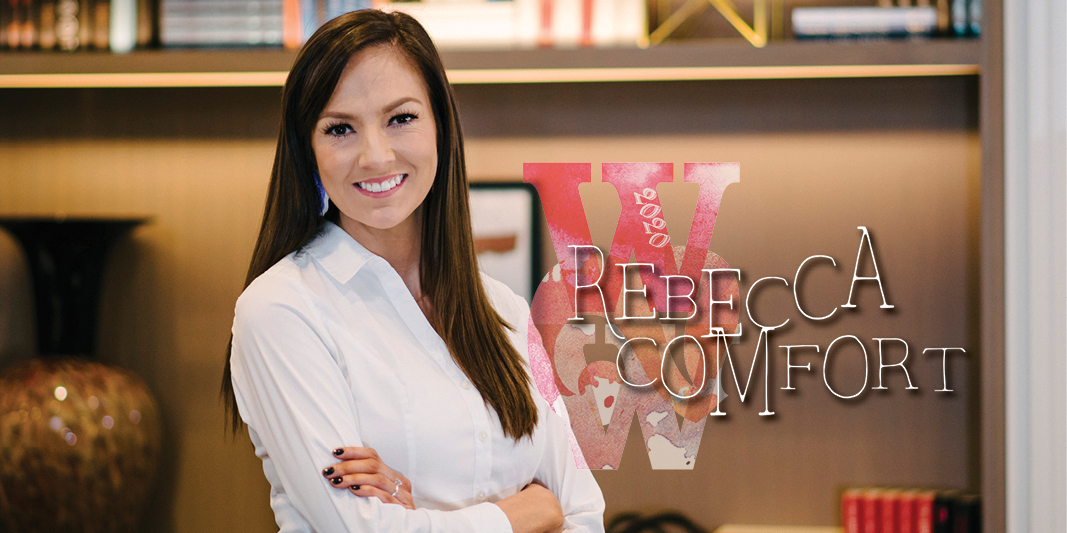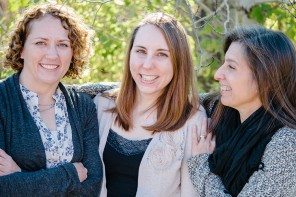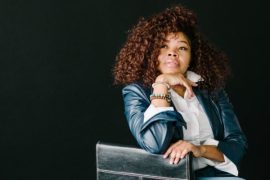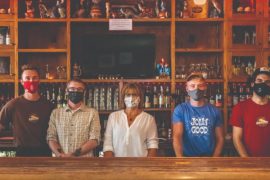By Julia Richards | Photographed by Hillary Schave on location at Hilton Madison Monona Terrace
The first thing Rebecca Comfort did when meeting me at the Memorial Union on the UW–Madison campus was to point out details in the décor that I had never noticed before. The inlay in the floor and mural on the ceiling of the second floor both reference the presence of American Indians in this place (and the appropriation of their cultures).
In her current role as American Indian Nations Liaison with the Wisconsin Historical Society, Comfort is similarly bringing attention to “the depth of Native presence in Wisconsin and the unique government-to-government relationships that exist between the state and each of the 12 tribal nations,” she says. Her leadership is helping to shape the Society and its programs to better serve tribal communities and educate Wisconsin residents about the historical and contemporary contributions of the American Indian nations.
“People don’t realize how diverse of a state Wisconsin is in terms of the makeup of the Native nations that we have,” Comfort says. Among the 12 tribes, six different languages are spoken representing three different language families, she says.
Comfort is working with the governments of those nations to develop long-term relationships and build trust with the tribes with the goal of moving forward together, away from the legacy of colonialism and the “exclusionary nature of more traditional museum paradigms,” Comfort explains.
“The Society recognized that there’s an absolute undeniable need for American Indians to be able to authentically and wholly control the narrative about their history, who we are, in a way that hasn’t been done before,” says Comfort, who is a member of the Keweenaw Bay Band of Lake Superior Ojibwe.
Christian Øverland, the Wisconsin Historical Society’s director, appreciates how Comfort keeps diversity and inclusivity on the agenda. “Her leadership in our organization is pervasive across all the departments in our organization and all the constituencies that we work with. So her impact on policy is terrific,” he says.
The Society is working to develop a new museum in the next five years to replace the current one across the street from the Capitol in Madison. Right now, the museum is organized chronologically with American Indians only represented in the pre-colonial period. This sticks them in the past, points out Comfort, rather than recognizing the continuous and contemporary Native presence in the state. Other ways of organizing displays, such as focused around place, may be more inclusive and authentic, Comfort suggests.
In 2020 she plans to establish an advisory committee to identify shared priorities with the tribes including shaping the new museum, as well as the Society’s collections of American Indian objects.
The new State Archive Preservation Facility includes an American Indian care suite designed to accommodate culturally appropriate care practices of resources in the Society’s collections. The suite includes dedicated collections storage and an adjacent indoor/outdoor area for use by cultural leaders.
Created in consultation with tribal representatives, the space facilitates access to and use of cultural assets and collaboration between tribal nations and the Society. Comfort sees the American Indian care suite as a tool to support the reconciliation of a difficult past and help bridge a disconnect that has exist- ed historically between tribal communities and traditional museum practices.
“We understand that our past is problematic, but we need to reconcile the fact that it happened, and ask where do we go from here?” Comfort says.
The suite is the first of its kind by any state government and is one of only two such facilities in the nation, the other located in Washington, D.C. at the Smithsonian’s National Museum of the American Indian.
As she moves into a new year Comfort is listening to the tribes’ priorities to make sure the relationships she is building can be longstanding and reciprocal. Part of this is ensuring that as the Society plans a new museum, Native people are able to tell their own stories.





Comments are closed.